
From left, students Devon Cottrill, Kyle Brooks, Trevor Somogyi, Sam Heckel, and Zachary Matthews
By Kyle Brooks ’17
Wildlife and Conservation Biology major
As they say, all good things must come to an end. Back in May, I published a post on this Forum about the beginning of my internship with Wayne National Forest. That internship has since come to an end, and I wanted to write a final post summarizing the project I worked on, along with a few parting thoughts.
The Project
What We Did
Beginning in early May, Devon Cottrill and I—both wildlife interns for Wayne National Forest—were tasked with surveying the wildlife along an approximate 30 mile section of the proposed Bailey Mountain Bike Trail. When finished, this proposed trail system would ultimately be a nearly 100-mile long trail system winding through parts of Wayne National Forest between Chauncey and Buchtel.
The internship program that Devon and I were part of arose as a joint venture between Ohio University and the United States Forest Service out of Wayne National Forest. Devon and I weren’t the only Ohio University students interning at Wayne National Forest this summer; Emily Penn and Trevor Somogyi from the Environmental and Plant Biology Department, and Zachary Matthews and Sam Heckle from the Sociology and Anthropology Department, were also part of this budding internship program with Wayne National Forest.
The surveys Devon and I were conducting this summer were just one part of the National Environmental Policy Act (NEPA). In accordance with NEPA, the United States Forest Service must conduct an environmental impact assessment for all proposed projects within national forests, including this Bailey Mountain Bike Trail project. This assessment is aimed at identifying how and what the project might negatively impact, and how best to mitigate those potential negative impacts. Devon and I were involved with the wildlife portion of this impact assessment, and our surveys were aimed at documenting all the animal species we could find and determining if the proposed trail route would impact any of those species.

Photo Credit: Wayne National Forest – Ohio University Wildlife Intern Kyle Brooks
We set out to accomplish this goal in three main steps. First, we walked the entirety of the section of the proposed trail we had been tasked with. During this initial walk through, we recorded any species we came across and mapped out any important or unusual habitat features we saw.
After we had walked the trail, we then consulted a list of sensitive, state-listed, and federally-listed animals which could have potentially been in the area. These sensitive or rare species were our main focus, as they would be the most at risk from a trail system like this. We dug into the literature and found out what kinds of habitats these sensitive species preferred or utilized. With that information, coupled with our habitat maps from the initial walk through, we identified any areas along the trail which met the habitat descriptions for the potential sensitive species.
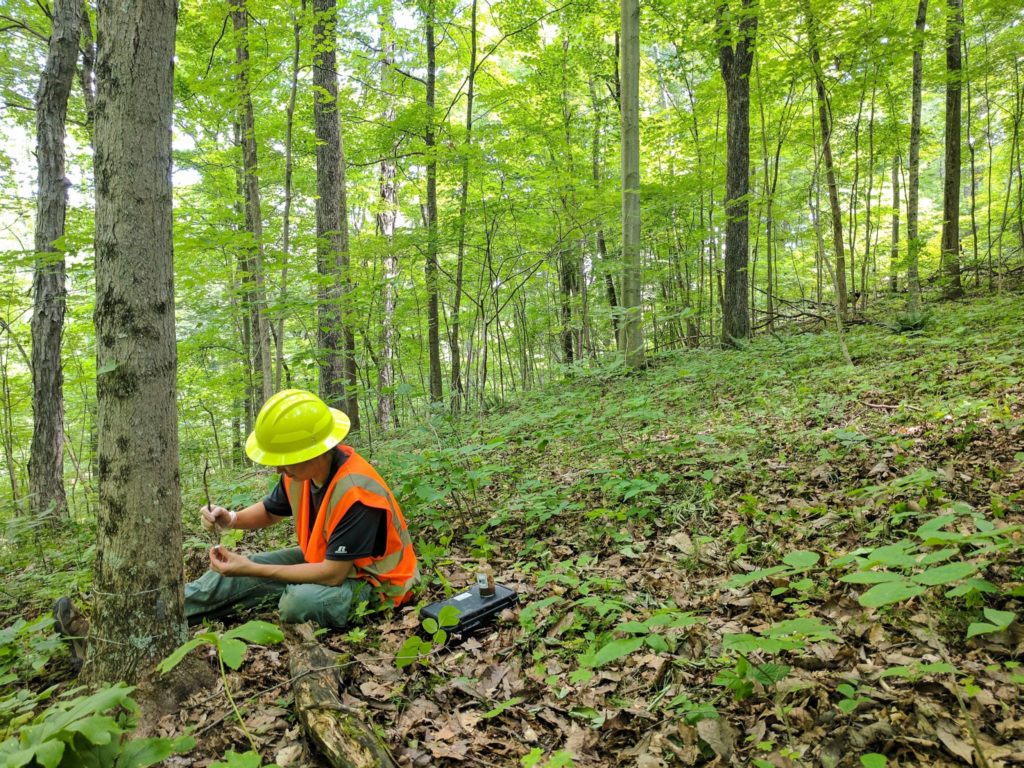
Devon Cottrill baiting a tree to attract mammals to a trail camera.
Photo Credit: Wayne National Forest – Ohio University Wildlife Intern Kyle Brooks
This led to our third and final step of the project. Devon and I now went back into the forest to target specific sections of the proposed trail in search of those rare and sensitive species. This is when we began utilizing a variety of survey methods. Not all wildlife surveying methods are the same; each method tends to focus on different groups of animals. For example, we put out trail cameras to record mammals, performed cover object surveys for reptiles and amphibians, and conducted point count surveys for breeding birds.
What We Found
Over the course of the summer, Devon and I recorded: 13 species of mammals, 72 species of birds, 9 species of reptiles, 9 species of amphibians, and many, many species of arthropods. So let’s break that down with some of the highlights for each group!

A Bobcat checks out one of our trail cameras. Photo Credit: Wayne National Forest
When it comes to the 13 species of mammals, the most notable were Gray Foxes and Bobcats. The presence of Gray Foxes is a good sign, as this species is experiencing a precipitous population decline across the state. The presence of these Gray Foxes implies that this section of Wayne National Forest is maintaining appropriate habitat for this troubled species. The presence of Bobcats is another great sign, but for a slightly different reason. Unlike the Gray Fox, which is declining across Ohio, Bobcats are actually increasing in number. The fact that at least two Bobcats call this section of Wayne National Forest home is a wonderful sign!
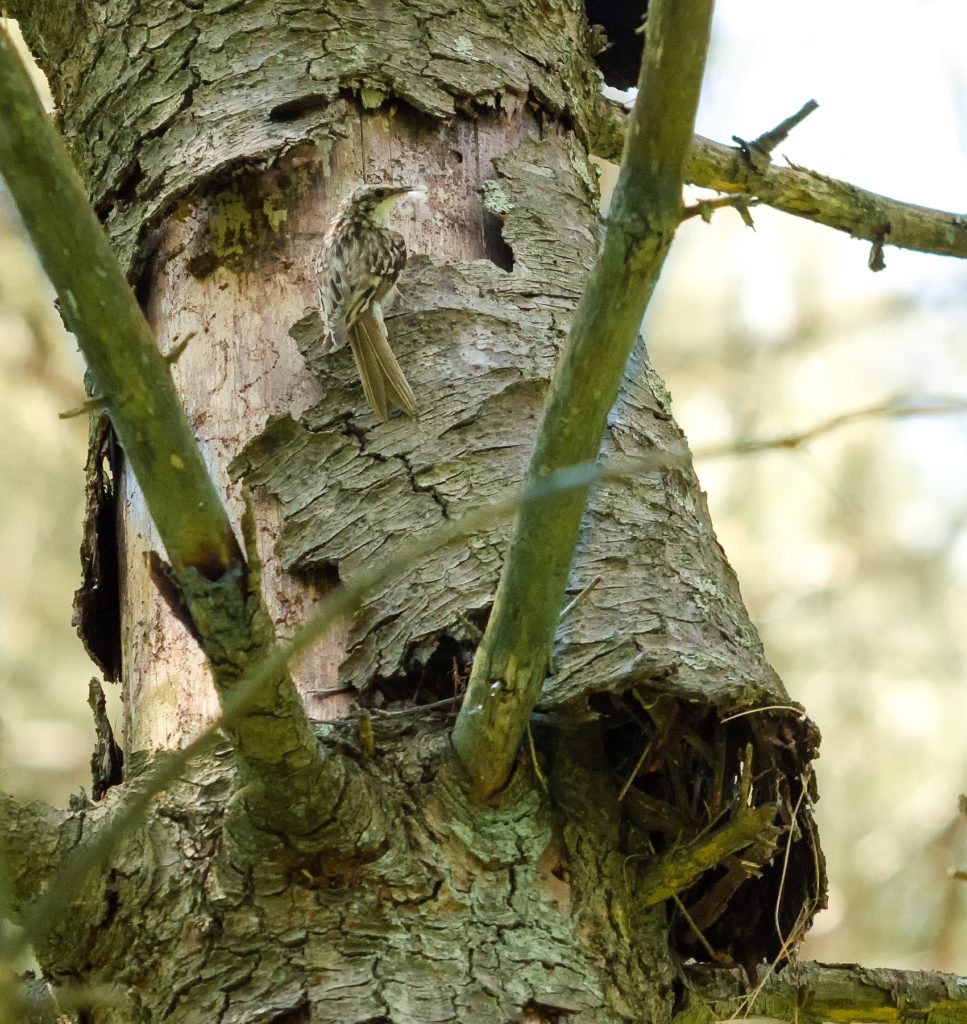
A female Brown Creeper perched atop her nest, which is placed underneath a piece of loose bark.
Photo Credit: Wayne National Forest – Ohio University Wildlife Intern Kyle Brooks
Of the 72 species of birds we recorded, there were several notable species. Five of the 72 species (Eastern Whip-Poor-Will, Wood Thrush, Cerulean Warbler, Kentucky Warbler, and Prairie Warbler) were included on the State of North America’s Birds “Watch List.” These “Watch List” species represent the most rapidly-declining bird species in North America, and they are consequently of great conservation importance. Like the presence of the Gray Foxes and Bobcats, the presence of these 5 “Watch List” species is a great sign, as this section of Wayne National Forest is obviously maintaining the appropriate habitat that each species requires.
The highlight with the birds was, by far, a pair of nesting Brown Creepers. This pair of Brown Creepers represents the first-ever recorded breeding attempt for this species in southeast Ohio, let alone Athens County. It should be noted that these Brown Creepers were not actually along the proposed trail corridor, but were instead a mile away. Devon and I stumbled across them while assisting with a project not associated with the Bailey Mountain Bike Trail project.
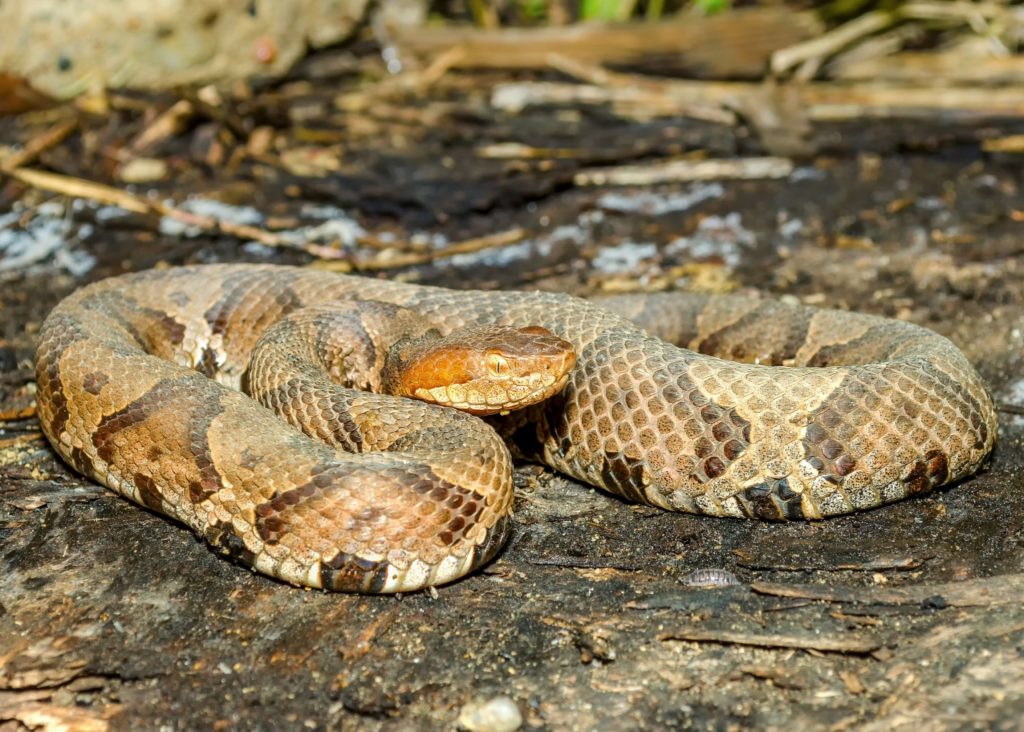
A Copperhead. Photo Credit: Wayne National Forest – Ohio University Wildlife Intern Kyle Brooks
When it comes to both reptiles and amphibians, all the species that Devon and I recorded were the usual suspects for southeastern Ohio. The parts of the trail which traveled through moist soils held amphibians like the Red-Backed Salamander, Northern Slimy Salamander, Long-Tailed Salamander, and Spring Peeper. Reptiles like the Eastern Box Turtle, Gray Ratsnake, and Northern Copperhead patrolled the forest as well. If you want to learn more about the snakes we saw, check out my previous post entitled “Working on the Wayne | Snazzy Snakes.”
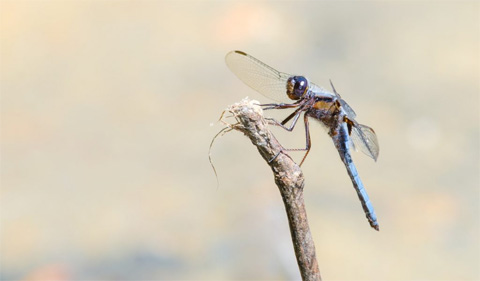
A state-endangered Blue Corporal perched upon a stick. Photo Credit: Wayne National Forest – Ohio University Wildlife Intern Kyle Brooks
In addition to all of the vertebrates we came across, we also took note of some of the invertebrates that we found. We placed an emphasis on the arthropods that were in decline—such as Monarchs—as well as the “Odonates.” The Odonates, which refers to the insect family Odonata, is a group that includes both dragonflies and damselflies. This summer began the Second Ohio Odonata Survey, which is a state-wide survey of dragonflies and damselflies. The goal is to update what species are present in Ohio, and where those species can be found.
We took part in this statewide survey by conducting our own surveys at Utah Pond and Big Bailey Wetland on Wayne National Forest property. We documented several common species, but our biggest find was discovering two brand new populations of the Blue Corporal, a state-endangered dragonfly species! If you want to take part in the Second Ohio Odonata Survey yourself, check out this link to find out more information.
What Will the Impacts Be?
Just how will this proposed mountain bike trail system impact the wildlife species present? Luckily, we don’t expect any significant negative impacts, which is great! We came to this conclusion by taking into account the size of the disturbance (in this case a dirt trail with a narrow width), the species present, and how those species typically interact with and use their habitat.
Let me give two examples, both using a sensitive species that we recorded from within the project area proper. The Cerulean Warbler—a quickly declining species in the US—was documented along many parts of the trail corridor. The Cerulean Warbler, however, is a tree-top specialist. They look for food high up in the canopy of trees, and build their nests high off the ground. Essentially, they spend the vast majority of their time high off the ground. The proposed trail would run along the ground, which means that the bikers and hikers using the trail would never interact with the Cerulean Warbler, and the Cerulean Warbler would never interact with the bikers and hikers. There would be no negative impact from this trail on any of the Cerulean Warblers present.

A Gray Fox captured on our trail cameras. Photo Credit: Wayne National Forest
Gray Foxes are another quickly declining species that are present in the area. The proposed trail, however, would not significantly impact this species. Gray Foxes are nocturnal animals, which means that when the Gray Foxes are active, there will be no hikers and bikers using the trail system, and vice versa. When humans will be using the trail, the Gray Foxes will be asleep deep in their dens, oblivious to the world around them.
There are a few short sections of the trail which will have to be altered slightly. These sections in question either run through, or near, important and sensitive habitat features. For example, one section of the trail is supposed to run straight through a system of vernal pools, which are of utmost importance for the reproduction of many amphibian species in Ohio. In this case, the trail simply needs to move a few dozen yards away from these vernal pools, and the problem is avoided. All of the other problematic sections of the proposed trail are just as easily fixed by the moving of the trail route.

Photo Credit: Wayne National Forest – Ohio University Wildlife Intern Kyle Brooks
The biggest impact on the wildlife of the area won’t come from the trail, but instead will come from any increased traffic driving along the gravel roads that crisscross the project area. As of now, these roads are lightly used, but there is a chance that more and more cars will begin using the roads when the trail opens. As a road gets used more and more by humans, the chances that an animal will get hit and killed increase greatly.

A female Eastern Box Turtle that fell victim to a careless driver. Photo Credit: Wayne National Forest – Ohio University Wildlife Intern Kyle Brooks
We already saw a great deal of road mortality over the summer. We passed dead Virginia Opossums, dead Northern Watersnakes, a dead Gray Fox, and dead Eastern Box Turtles. For example, in the photo above is a dead Eastern Box Turtle. This was a female turtle who was carrying eggs. A careless driver didn’t take the time to slow down and avoid the turtle, resulting in the death of not only the female, but all of her future offspring as well.
An entity like Wayne National Forest cannot mitigate a problem like this. Instead, a problem like this must be solved by a change in the local culture. When driving in your car, I implore you to brake for wildlife. We came across several live animals crossing the gravel roads over the summer, and we always had plenty of time and distance to stop and let the animal safely cross. Accidents happen, but we as a society must try to avoid striking and killing animals crossing the road when we can do so.
All Things Must End
I believe it is safe to say that the thought of the time after graduating is an intimidating prospect for the majority of students; at least it was for me. When I graduated in late April of 2017, I had entered the “real world,” for lack of a better description. Thankfully, this internship at Wayne National Forest allowed me to not only get a taste of what sorts of jobs I could be working in the future, but also gave me the opportunity to learn new skills and gain more relevant experience.
Wildlife biology is an interesting career path. This path requires you to not only have a conceptual education, but also requires that you have experience “in the field.” First and foremost, it is important to gain a fundamental conceptual education, which the classes at Ohio University strive to give you. For those of you who aren’t wildlife and conservation biology majors, we wildlife majors take classes like Field Ecology (in which we learn to design experiments and formally write up the results), Ornithology (in which we learn bird biology and how to identify bird species), and Animal Ecology (in which we learn about the concepts driving the latest research in understanding how animals interact with each other and their environment). These classes are primarily centered around classroom lectures, and they give students the fundamental conceptual education they will utilize in their future.
However, having an understanding of scientific concepts and methods is only half the battle for the wildlife student. You also need hands on experience working in the field. Jobs often require applicants to have experience with things such as “experience backpacking or camping in remote areas” or “experience operating 4WD vehicles on rough dirt roads.” They also require applicants to be okay with things like “wading through swamps with Alligators and Cottonmouths” and “walking 6-8 miles a day in the mountains during winter.” These are experiences that the classroom does not and simply cannot teach you.
This is where internships and getting involved in undergraduate research comes in. I personally became involved in undergraduate research my sophomore year at Ohio University, and I began learning skills that the classroom cannot teach you. I spent the summers of 2015 and 2016 interning as a field assistant for graduate students—Maggie Hantak in Dr. Shawn Kuchta’s lab and Anthony Gilbert in Dr. Donald Mile’s lab. These experiences taught me how to do things like how to stomach-flush a tiny salamander, or how to catch a lizard with a noose on a fishing pole, or how to safely navigate deserts in the heat of the Arizona summer.
In other words, you pick up a range of useful and sometimes weird skills when you get involved outside of the classroom.
So how did this internship at Wayne National Forest fit in? First, I had to already have some skills in order to properly meet the project requirements. The main bulk of this internship involved finding and identifying animals. To do this, I had to already know how to identify many different species out in the field without reference books to aid me. For example, when I conducted point count surveys for birds, I had to know how to identify all the species from their song.
“Teacher-Teacher-TeaCHER-TeaCHER-TEACHER-TEACHER!” Ovenbird. “Tawhoot-tawhoot-tawhoot-teewhoo!” Hooded Warbler.
But this internship also taught me many new skills. For example, I learned how to properly set up and bait a trail camera in order to survey for mammals. I learned how to utilize handheld mapping programs like AVENZA to record data. And probably most importantly, I learned how to use GIS (Geographic Information Systems) programs to map out data we collected in the field and try to predict where a given species might possibly reside.
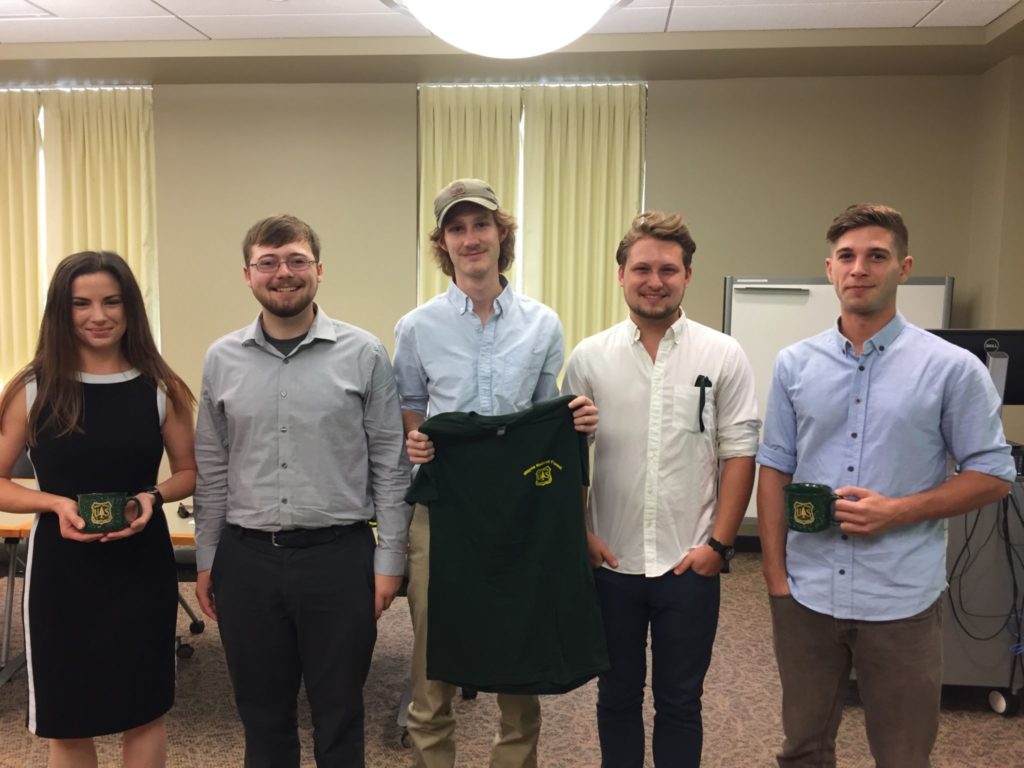
(Left to Right) Students Devon Cottrill, Kyle Brooks, Trevor Somogyi, Sam Heckle, and Zachary Matthews
This was an absolutely wonderful experience, and I am grateful that both the United States Forest Service at Wayne National Forest and Ohio University allowed me to have this opportunity. I want to especially thank Lynda Andrews, wildlife biologist with the USFS, and Dr. Viorel Popescu, professor in the Biological Sciences Department at Ohio University, for giving Devon and I the direction and help that we needed in order to fulfill this project.
Thanks so much for reading!
– – –
Kyle Brooks is a recent graduate of Ohio University, where he received a bachelor of science degree in wildlife and conservation biology. To read more topics on Ohio nature, visit his blog.



















Comments